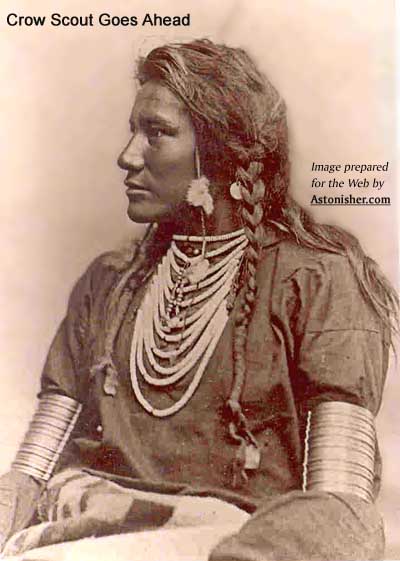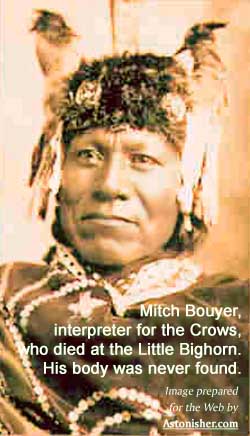|
|||||||||||
Bruce Brown's 100 Voices... Goes Ahead's Story of the Battle, #1
The roll was called at the bank at the boat for these Crow scouts. Six of them were called to go on board, Hairy Moccasin, White-Man-Runs-Him, Goes-Ahead, Curley, Half-Yellow-Face, White Swan. The boat went up a little way and landed the scouts. Their interpreter was Mitch Bouyer (Ka-pesh), a half-breed Dakota. He told them that when they went down below the mouth of the Rosebud they would see Arikara scouts. When they came to this camp there was a big tent with a flag, and in it they met Custer. He shook hands with them and said, "We are glad to have you, we sent for you and you came right away." Custer told them he was going to fight the Dakotas and Cheyennes and that he understood that the Crows were good scouts. "If we win the fight, everything belonging to the enemy you can take home, for my boys have no use for these things." The next day they broke camp and went up the Rosebud until night. Next day they found where the Dakotas had their first camp, a very big one. They had had a sun dance, they could see the frame of the dance lodge. The third day they camped at what is now Busby School, the second camp on the Rosebud. Just at dawn they reached Wolf Mountains, the sun was just coming up. Custer always warned them to look out for themselves, for every squad of soldiers had scouts and they might be mistaken for the enemy. Custer said to the six Crow scouts: "If nothing happens to me I will look after you in the future." From Wolf Mountains the Crow scouts were ahead but stopped a moment at the lone tepee. At White Rocks, Mitch Bouyer told them to go with Custer.
The Arikara Narrative of Custer's Campaign against the Hostile Dakotas, June 1876, edited by Orin Grant Libby, North Dakota Historical Collections, Volume 6, State Historical Society of North Dakota, Bismark, ND, 1920 p 157 - 160
In addition to confirming the story the two other Crow scouts who were with him -- White Man Runs Him and Hairy Moccasin -- told of riding with Custer down Medicine Tail Coulee to attack the Indian village, Goes Ahead 's acounts of the Battle of the Little Bighorn are important because they describe two crucial details not mentioned by the others. In his interview with Orin Grant Libby, Goes Ahead mentioned one of the enduring mysteries of the Battle of the Little Bighorn -- the double volley fired by Custer's men shortly after they tried to charge across the Little Bighorn to attack the village and were repulsed by less than a dozen warriors, some of whom lacked guns, as White Cow Bull and Bobtailed Horse described. The Accepted Consensus View of the Battle has no good explanation for how ten warriors could turn back 200-plus cavalry troopers who were "coming fast" with Custer in the lead, and it similarly has no good explanation for why Custer's men would then fire a double volley -- which Custer's orderly, John Burkman, took to be a distress signal -- at the very beginning of the Custer fight. The second double volley possibly fired by Custer's men later in the battle, when they were under ferocious assault, is much easier to explain, tactically and psychologically, but why would Custer's men fire a double volley at the beginning when there were few Sioux and Cheyenne warriors opposing them? It makes no sense unless you know that White Cow Bull had just blasted Custer out of the saddle in the middle of the Little Bighorn River, and even though the Indians hasn't massed significant force against them yet, Custer's men already were in mortal distress. See Who Killed Custer -- The Eye-Witness Answer for more info. In his 1916 Tepee Book account of the battle, Goes Ahead mentioned another important detail overlooked by his two companions -- that the three of them went down to the Little Bighorn River on their own, AFTER Custer headed down Medicine Tail Coulee to attack the Indian village, and BEFORE the Custer fight began. This is important because it tallies with the account of Seventh Cavalry Pvt. Peter Thompson, who was amazed to encounter one of the Seventh Cavalry's Crow scouts with a Sioux squaw on a tether while he was wandering lost along the Little Bighorn just before the Custer fight began. Like the Arikara scouts at the outset of Reno's charge a half hour before, it appears at least one of the Crow scouts with Custer was looking for a little rape and/or murder action among the Sioux and Cheyenne women on the curling edge of Custer's charge. Curley could be Crow scout Thompson caught in the middle of a war crime since he admitted he was in a position to see two of Custer's men shot out of the saddle when they tried to charge across the Little Bighorn at Medicine Tail Coulee, but it could also be one of the other Crow scouts -- Hairy Mocassin, White Man Runs Him and Goes Ahead -- since Goes Ahead said the three of them went together to the river for a "drink of water" after they left Custer -- exactly the moment Thompson said he saw the Crow Scout with the roped squaw. * * * All the Indians -- friendly and hostile -- were very guarded about what they said about the battle to the Americans, which is understandable given the Americans' murderous history. But a full and candid account of the battle as the Crow scouts observed it is contained in the story told by Pretty Shield, who was the wife of Goes Ahead and the neice of Half Yellow Face, leader of the Crow scouts. Pretty Shield fills in the blanks left in the accounts of Goes Ahead, Hairy Moccasin and White Man Runs Him. * * * Goes Ahead was the husband of crucial Crow Chronicler Pretty Shield. * * * Here is another account of the battle by Goes Ahead. For more information on Custer's scouts, please see The Twisted Saga of the Unsung Seventh Cavalry Scouts. -- Bruce Brown
|
|||||||||||




 THE SOLDIERS were encamped where still water flows into the Yellowstone. They went on to where Powder River joins the Yellowstone. The Crows were on the north side of the Yellowstone and the soldiers wanted to cross but it was too high. General Terry had a canoe. Then a steamboat came up the Yellowstone, opposite the mouth of the Rosebud. Some of the Crow scouts got on this boat and went across.
THE SOLDIERS were encamped where still water flows into the Yellowstone. They went on to where Powder River joins the Yellowstone. The Crows were on the north side of the Yellowstone and the soldiers wanted to cross but it was too high. General Terry had a canoe. Then a steamboat came up the Yellowstone, opposite the mouth of the Rosebud. Some of the Crow scouts got on this boat and went across.








